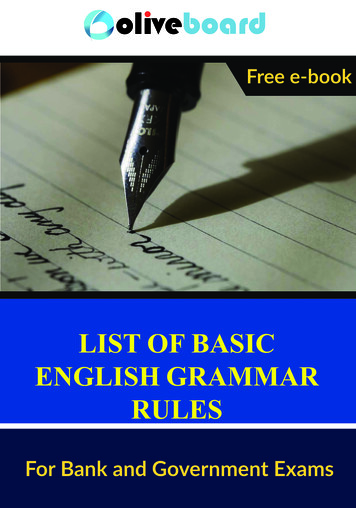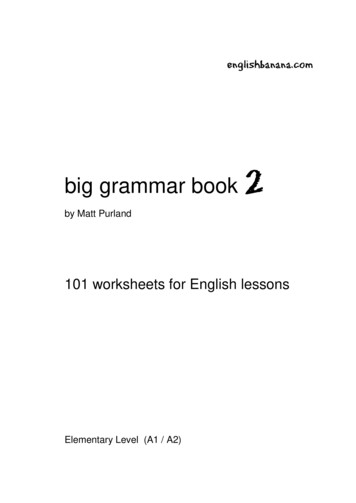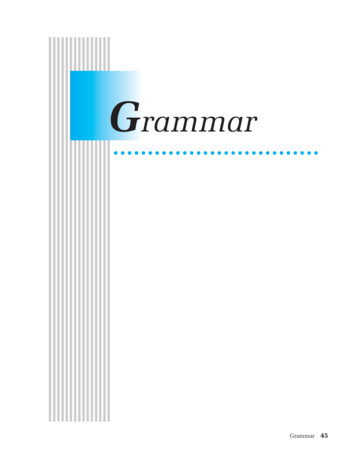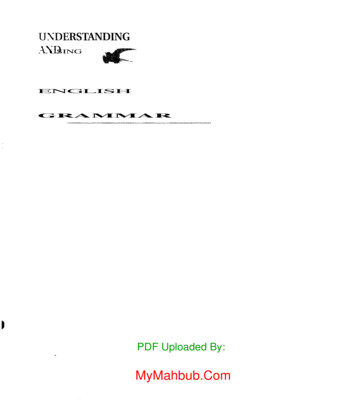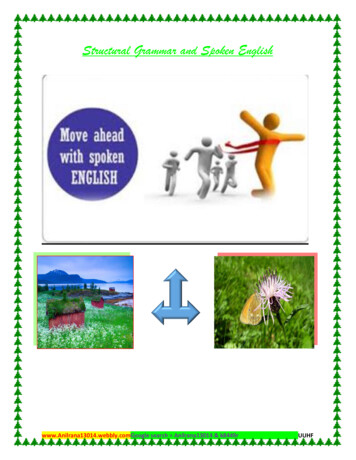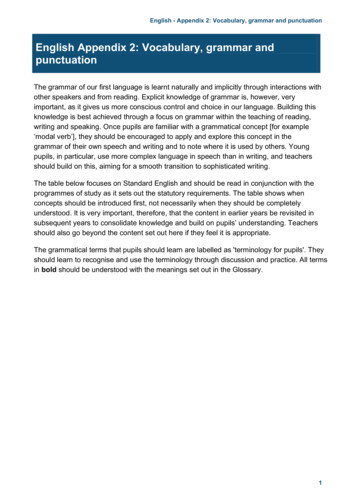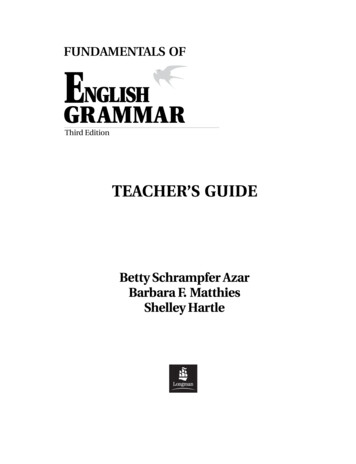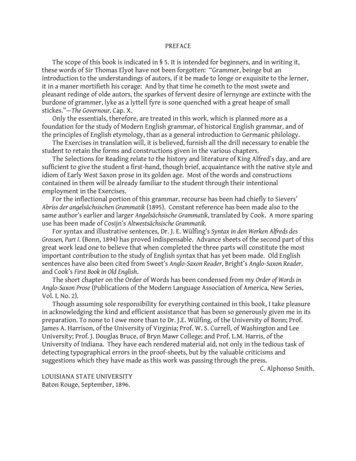
Transcription
PREFACEThe scope of this book is indicated in § 5. It is intended for beginners, and in writing it,these words of Sir Thomas Elyot have not been forgotten: “Grammer, beinge but anintroduction to the understandings of autors, if it be made to longe or exquisite to the lerner,it in a maner mortifieth his corage: And by that time he cometh to the most swete andpleasant redinge of olde autors, the sparkes of fervent desire of lernynge are extincte with theburdone of grammer, lyke as a lyttell fyre is sone quenched with a great heape of smallstickes.”—The Governour, Cap. X.Only the essentials, therefore, are treated in this work, which is planned more as afoundation for the study of Modern English grammar, of historical English grammar, and ofthe principles of English etymology, than as a general introduction to Germanic philology.The Exercises in translation will, it is believed, furnish all the drill necessary to enable thestudent to retain the forms and constructions given in the various chapters.The Selections for Reading relate to the history and literature of King Alfred’s day, and aresufficient to give the student a first-hand, though brief, acquaintance with the native style andidiom of Early West Saxon prose in its golden age. Most of the words and constructionscontained in them will be already familiar to the student through their intentionalemployment in the Exercises.For the inflectional portion of this grammar, recourse has been had chiefly to Sievers’Abriss der angelsächsischen Grammatik (1895). Constant reference has been made also to thesame author’s earlier and larger Angelsächsische Grammatik, translated by Cook. A more sparinguse has been made of Cosijn’s Altwestsächsische Grammatik.For syntax and illustrative sentences, Dr. J. E. Wülfing’s Syntax in den Werken Alfreds desGrossen, Part I. (Bonn, 1894) has proved indispensable. Advance sheets of the second part of thisgreat work lead one to believe that when completed the three parts will constitute the mostimportant contribution to the study of English syntax that has yet been made. Old Englishsentences have also been cited from Sweet’s Anglo-Saxon Reader, Bright’s Anglo-Saxon Reader,and Cook’s First Book in Old English.The short chapter on the Order of Words has been condensed from my Order of Words inAnglo-Saxon Prose (Publications of the Modern Language Association of America, New Series,Vol. I, No. 2).Though assuming sole responsibility for everything contained in this book, I take pleasurein acknowledging the kind and efficient assistance that has been so generously given me in itspreparation. To none to I owe more than to Dr. J.E. Wülfing, of the University of Bonn; Prof.James A. Harrison, of the University of Virginia; Prof. W. S. Currell, of Washington and LeeUniversity; Prof. J. Douglas Bruce, of Bryn Mawr College; and Prof. L.M. Harris, of theUniversity of Indiana. They have each rendered material aid, not only in the tedious task ofdetecting typographical errors in the proof-sheets, but by the valuable criticisms andsuggestions which they have made as this work was passing through the press.C. Alphonso Smith.LOUISIANA STATE UNIVERSITYBaton Rouge, September, 1896.
iiTABLE OF CONTENTSPART I.—INTRODUCTIONChaptersI.History (§1-2). 1II. Sounds (§ 3-6). 3III. Inflections (§7-10). 7IV. Order of Words (§ 11-12).11V. Practical Suggestions (§ 13-15). 13PART II.—ETYMOLOGY AND I.XVIII.XIX.XX.XXI.XXII.The a-Declension: Masculine a—Stems (§ 16-18).16Neuter a-Stems (§ 19-21). 19The ō-Declension (§ 22-24).22The i-Declension and the u-Declension (§ 25-29). 25Present Indicative Endings of Strong Verbs (§ 30-34). 30The Weak or n-Declension (§ 35-37).35Remnants of Other Consonant Declensions (§ 38-41).38Pronouns (§ 42-44).42Adjectives, Strong and Weak (§ 45-48).45Numerals (§ 49-51).49Adverbs, Prepositions, and Conjunctions (§ 52-54).52Comparsions of Adjectives and Adverbs (§ 55-59). 55Strong Verbs: Class, Syntax of Moods (§ 60-63). 60Classes II and III (§ 64-67). 64Classes IV, V, VI, and VII (§ 68-72). 68Weak Verbs (§ 73-79). 73Remaining Verbs; Verb-Phrases (§ 80-86). 80
OLD ENGLISH GRAMMAR AND EXERCISE BOOK.PART I.INTRODUCTION.CHAPTER I.HISTORY.1.The history of the English language falls naturally into three periods; but theseperiods blend into one another so gradually that too much significance must not be attachedto the exact dates which scholars, chiefly for convenience of treatment, have assigned as theirlimits. Our language, it is true, has undergone many and great changes; but its continuity hasnever been broken, and its individuality has never been lost.2.The first of these periods is that of OLD ENGLISH, or ANGLO-SAXON,1 commonlyknown as the period of full inflections. E.g. stān-as, stones; car-u, care; will-a, will; bind-an, to bind;help-að ( ath), they help.It extends from the arrival of the English in Great Britain to about one hundred years afterthe Norman Conquest,—from A.D. 449 to 1150; but there are no literary remains of the earliercenturies of this period. There were four2 distinct dialects spoken at this time. These were theNorth-umbrian, spoken north of the river Humber; the Mercian, spoken in the midland regionbetween the Humber and the Thames; the West Saxon, spoken south and west of the Thames;and the Kentish, spoken in the neighborhood of Canterbury. Of these dialects, Modern Englishis most nearly akin to the Mercian; but the best known of them is the West Saxon. It was in theWest Saxon dialect that King Alfred (849-901) wrote and spoke. His writings belong to theperiod of Early West Saxon as distinguished from the period of Late West Saxon, the latterbeing best represented in the writings of Abbot Ælfric (955?-1025?).3. The second period is that of MIDDLE ENGLISH, or the period of leveled inflections, thedominant vowel of the inflections being e. E.g. ston-es, car-e, will-e, bind-en (or bind-e),help-eth, each being, as in the earlier period, a dissyllable.The Middle English period extends from A.D. 1150 to 1500. Its greatest representatives areChaucer (1340-1400) in poetry and Wiclif (1324-1384) in prose. There were three prominentdialects during this period: the Northern, corresponding to the older Northumbrian; theMidland (divided into East Midland and West Midland), corresponding to the Mercian; and theSouthern, corresponding to the West Saxon and Kentish. London, situated in East Midlandterritory, had become the dominant speech center; and it was this East Midland dialect thatboth Chaucer and Wiclif employed.NOTE.—It is a great mistake to think that Chaucer shaped our language from crude materials. His influencewas conservative, not plastic. The popularity of his works tended to crystalize and thus to perpetuate the forms1 This unfortunate nomenclature is due to the term Angli Saxones, which Latin writers used as adesignation for the English Saxons as distinguished from the continental or Old Saxons. But Alfred and Ælfricboth use the term Englisc, not Anglo-Saxon. The Angles spread over Northumbria and Mercia, far outnumberingthe other tribes. Thus Englisc ( Angel isc) became the general name for the language spoken.2 As a small as England is, there are six distinct dialects spoken in her borders to-day. Of these theYorkshire dialect is, perhaps, the most peculiar. It preserves many Northumbrian survivals. See Tennyson’sNorthern Farmer.
2of the East Midland dialect, but that dialect was ready to his hand before he began to write. The speech of Londonwas, in Chaucer’s time, a mixture of Southern and Midland forms, but the Southern forms (survivals of the WestSaxon dialect) had already begun to fall away; and this they continued to do, so that “Chaucer’s language,” as Dr.Murray says, “is more Southern than standard English eventually became.” See also Morsbach, Ueber den Ursprungder neuenglischen Schriftsprache (1888).4. The last period is that of MODERN ENGLISH, or the period of lost inflections. E.g. stones,care, will, bind, help, each being a monosyllable. Modern English extends from A.D. 1500to the present time. It has witnessed comparatively few grammatical changes, but thevocabulary of our language has been vastly increased by additions from the classicallanguages. Vowels, too, have shifted their values.5. It is the object of this book to give an elementary knowledge of Early West Saxon prose,or the language of King Alfred. With this knowledge, it will not be difficult for thestudent to read Late West Saxon, or any other dialect of the Old English period. Suchknowledge will also serve as the best introduction to the structure both of MiddleEnglish and of Modern English, besides laying a secure foundation for the scientificstudy of any other Germanic tongue.NOTE.—The Germanic, or Teutonic, languages constitute a branch of the great Aryan, or IndoGermanic (known also as the Indo-European) group. They are subdivided as follows:North Germanic: Scandinavian, or Norse.GermanicEast Germanic:Gothic.High GermanOld High German,(to A.D. 1100,)Middle High German,(A.D. 1100-1500,)New High German.(A.D. 1500-.)West GermanicLow GermanDutch,Old Saxon,Frisian,English.
3Chapter II.SOUNDS.Vowels and Diphthongs.6. The long vowels and diphthongs will in this book be designated by the macron ( ).Vowel length should in every case be associated by the student with each word learned:quantity alone sometimes distinguishes words meaning wholly different things: fōr, hewent, for, for; gōd, good, god, God; mān, crime, man, man.Long vowels and diphthongs:ā as in father: stān, a stone.ǣ as in man (prolonged): slǣpan, to sleep.ē as in they: hēr, here.ī as in machine: mīn, mine.ō as in note (pure, not diphthongal): bōc, book.ū as in rule: tūn, town.ȳ as in German grün, or English green (with lips rounded):1 brȳd, bride.The diphthongs, long and short, have the stress upon the first vowel. The second vowel isobscured, and represents approximately the sound of er in sooner, faster ( soon-uh, fast-uh). Thelong diphthongs (ǣ is not a diphthong proper) are ēo, īe, and ēa. The sound of ēo isapproximately reproduced in mayor ( mā-uh); that of īe in the dissyllabic pronunciation of fear( fē-uh). But ēa œ̅-uh. This diphthong is hardly to be distinguished from ea in pear, bear, etc.,as pronounced in the southern section of the United States ( bœ-uh, pœ-uh).7. The short sounds are nothing more than the long vowels and diphthongs shortened;but the student must at once rid himself of the idea that modern English red, forexample, is the shortened form of reed, or that mat is the shortened form of mate.Pronounce these long sounds with increasing rapidity, and reed will approach rid, whilemate will approach met. The Old English short vowel sounds are:aæe, ęas in artistic: habban, to have.as in mankind: dæg, day.as in let: stelan, to steal, sęttan, to set.ias in sit: hit, it.oas in broad (but shorter): god, God.ǫas in not: lǫmb, lamb.uas in full: sunu, son.yas in miller (with lips rounded): gylden, golden.NOTE:—The symbol ę is known as umlaut-e (§ 58). It stands for Germanic a, while e (without the cedilla)1 Vowels are said to be round, or rounded, when the lip-opening is rounded; that is, when the lips arethrust out and puckered as if preparing to pronounce w. Thus o and u are round vowels: add –ing to each, andphonetically you have added –wing. E.g. gowing, suwing.
4represents Germanic e. The symbol ǫ is employed only before m and n. It, too, represents Germanic a. But Alfredwrites manig or monig, many; lamb or lomb, lamb; hand or hond, hand, etc. The cedilla is an etymological signadded by modern grammarians.Consonants.8. There is little difference between the values of Old English consonants and those ofModern English. The following distinctions, however, require notice:The digraph th is represented in Old English texts by ð and þ, no consistent distinctionbeing made between them. In the works of Alfred, ð (capital, Ð) is the more common: ðās,those; ðæt, that; bindeð, he binds.The consonant c had the hard sound of k, the latter symbol being rare in West Saxon:cyning, king; cwēn, queen; cūð, known. When followed by a palatal vowel sound,—e, i, œ, ea, eo,long or short,—a vanishing y sound was doubtless interposed (cf. dialectic kyind for kind). InModern English the combination has passed into ch: cealc, chalk; cīdan, to chide; lǣce, leech; cild,child; cēowan, to chew. This change (c ch) is known as Palatalization. The letter g, pronouncedas in Modern English gun, has also a palatal value before the palatal vowels (cf. dialectic gyirl forgirl).The combination cg, which frequently stands for gg, had probably the sound of dge inModern English edge; ęcg, edge; sęcgan, to say; brycg, bridge.Initial h is sounded as in Modern English: habban, to have; hālga, saint. When closing asyllable it has the sound of German ch: slōh, he slew; hēah, high; ðurh, through.9. An important distinction is that between voiced (or sonant) and voiceless (or surd)consonants.1 In Old English they are as follows:VOICED.gdð, þ (as in though)bf ( v)s ( z)VOICELESS.h, ctð, þ (as in thin)pfsIt is evident, therefore, that ð (þ), f, and s have double values in Old English. If voiced, theyare equivalent to th in (though), v, and z. Otherwise, they are pronounced as th (in thin), f (infin), and s (in sin). The syllabic environment will usually compel the student to give theseletters their proper values. When occurring between vowels, they are always voiced: ōðer,other; ofer, over; rīsan, to rise.NOTE.—The general rule in Old English, as in Modern English, is, that voiced consonants have a specialaffinity for other voiced consonants, and voiceless for voiceless. This is the law of Assimilation. Thus when de isadded to form the preterit of a verb whose stem ends in a voiceless consonant, the d is unvoiced, or assimilated, tot: sęttan, to set, sętte (but tręddan, to tread, has trędde); slǣpan, to sleep, slǣpte; dręncan, to drench, dręncte;cyssan, to kiss, cyste. See § 126, Note 1.1A little practice will enable the student to see the appropriateness of calling these consonants voicedand voiceless. Try to pronounce a voiced consonant,—d in den, for example, but without the assistance of en,—andthere will be heard a gurgle, or vocal murmur. But in t, of ten, there is no sound at all, but only a feeling of tensionin the organs.
5Syllables.10. A syllable is usually a vowel, either alone or in combination with consonants, utteredwith a single impulse of stress; but certain consonants may form syllables: oven ( ov-n), battle( bœt-l); (cf. also the vulgar pronunication of elm).A syllable may be (1) weak or strong, (2) open or closed, (3) long or short.(1) A weak syllable receives a light stress. Its vowel sound is often different from that ofthe corresponding strong, or stressed, syllable. Cf. weak and strong my in “I want my lárgehat” and “I want mý hat.”(2) An open syllable ends in a vowel or diphthong: dē-man, to deem; ðū, thou; sca-can, toshake; dæ-ges, by day. A closed syllable ends in one or more consonants: ðing, thing; gōd, good;glæd, glad.(3) A syllable is long (a) if it contains a long vowel or a long diphthong: drī-fan, to drive; lūcan, to lock; slǣ-pan, to sleep; cēo-san; to choose, (b) if its vowel or diphthong is followed by morethan one consonant:1 cræft, strength; heard, hard; lib-ban, to live; feal-lan, to fall. Otherwise, thesyllable is short: ðe, which; be-ran, to bear; ðæt, that; gie-fan, to give.NOTE 1.—A single consonant belongs to the following syllable: hā-lig, holy (not hāl-ig); wrī-tan, to write; fæder, father.NOTE 2.—The student will notice that the syllable may be long and the vowel short; but the vowel cannot belong and the syllable short.NOTE 3.—Old English short vowels, occurring in open syllables, have regularly become long in ModernEnglish: we-fan, to weave; e-tan, to eat; ma-cian, to make; na-cod, naked; a-can, to ache; o-fer, over. And Old Englishlong vowels, preceding two or more consonants, have generally been shortened: brēost,breast; hǣlð, health;slǣpte, slept; lǣdde, led.Accentuation.11. The accent in Old English falls usually on the radical syllable, never on the inflectionalending: bríngan, to bring; stā́nas, stones; bérende, bearing; ī́delnes, idleness; frḗonscipe,friendship.But in the case of compound nouns, adjectives, and adverbs the first member of thecompound (unless it be ge- or be-) receives the stronger stress: héofon-rīce, heaven-kingdom;ǫ́nd-giet, intelligence; sðo-fæst, truthful; gód-cund, divine; éall-unga, entirely; blíðe-līce,blithely.But be-haā́t, promise; ge-béd, prayer; gefḗalīc, joyous; be-sōne, immediately.Compound verbs, however, have the stress on the radical syllable: for-gíefan, to forgive; oflínnan, to cease; ā-cnā́wan, to know; wið-stǫ́ndan, to withstand; on-sácan, to resist.NOTE.—The tendency of nouns to take the stress on the prefix, while verbs retain it on the root, isexemplified in many Modern English words: préference, prefér; cóntract (noun), contráct (verb); ábstinence, abstaín;pérfume (noun), perfúme (verb).CHAPTER III.INFLECTIONS.1Taken separately, every syllable ending in a single consonant is long. It may be said, therefore, that allclosed syllables are long; but in the natural flow of language, the single final consonant of a syllable so oftenblends with a following initial vowel, the syllable thus becoming open and short, that such syllables are notrecognized as prevailingly long. Cf. Modern English at all ( a-tall).
6Cases.12. There are five cases in Old English: the nominative, the genitive, the dative, theaccusative, and the instrumental.1 Each of them, except the nominative, may begoverned by prepositions. When used without propositions, they have, in general, thefollowing functions:(a) The nominative, as in Modern English, is the case of the subject of a finite verb.(b) The genitive (the possessive case of Modern English) is the case of the possessor orsource. It may be called the of case.(c) The dative is the case of the indirect object. It may be called the to or for case.(d) The accusative (the objective case of Modern English) is the case of the direct object.(e) The instrumental, which rarely differs from the dative in form, is the case of themeans or the method. It may be called the with or by case.The following paradigm of mūð, the mouth, illustrates the several cases (the article being,for the present, gratuitously added in the Modern English equivalents):N.G.D.A.I.Singular.mūð the mouth.mūð-es2 of the mouth( the mouth’s).mūð-e to or for the mouth.mūð the mouth.mūðe with or by means ofthe mouth.Plural.mūð-as the mouths.mūð-a of the mouths.( the mouths’).mūð-um to or for the mouths.mūð-as the mouths.mūð-um with or by means ofthe mouths.Gender.13. The gender of Old English nouns, unlike that of Modern English, depends partly onmeaning and partly on form, or ending. Thus mūð, mouth, is masculine; tunge, tongue,feminine; ēage, eye, neuter.No very comprehensive rules, therefore, can be given; but the gender of every noun shouldbe learned with its meaning. Gender will be indicated in the vocabularies by the differentgender forms of the definite article, sē for the masculine, sēo for the feminine, and ðæt for theneuter: sē, mūð, sēo tunge, ðæt ēage the mouth, the tongue, the eye.All nouns ending in –dōm, -hād, -scipe, or –ere are masculine (cf. Modern English wisdom,childhood, friendship, worker). Masculine, also, are nouns ending in –a.Those ending in –nes or –ung are feminine (cf. Modern English goodness, and gerundialforms in –ing: see-ing is believing).Thus sē wīsdōm, wisdom; sē cildhād, childhood; sē frēondscipe, friendship; sē fiscere, fisher1Most grammars add a sixth case, the vocative. But it seems best to consider the vocative as only afunction of the nominative form.2Of course our “apostrophe and s” ( ’s) comes from the Old English genitive ending –es. The e ispreserved in Wednesday ( Old English Wōdnes dæg). But at a very early period it was thought that John’s book, forexample, was a shortened form of John his book. Thus Addison (Spectator, No. 135) declares’s a survival of his. How,then, would he explain the s of his? And how would he dispose of Mary’s book?
7(man); sē hunta, hunter; sēo gelīcnes, likeness; sēo leornung, learning.Declensions.14. There are two great systems of declension in Old English, the Vowel Declension and theConsonant Declension. A noun is said to belong to the Vowel Declension when the finalletter of its stem is a vowel, this vowel being then known as the stem-characteristic; but ifthe stem-characteristic is a consonant, the noun belongs to the Consonant Declension.There might have been, therefore, as many subdivisions of the Vowel Declension in OldEnglish as there were vowels, and as many subdivisions of the Consonant Declension asthere were consonants. All Old English nouns, however, belonging to the VowelDeclension, ended their stems originally in a, ō, i, or u. Hence there are but foursubdivisions of the Vowel Declension: a-stems, ō-stems, i-stems, and u-stems.The Vowel Declension is commonly called the Strong Declension, and its nounsStrong Nouns.NOTE.—The terms Strong and Weak were first used by Jacob Grimm (1785-1863) in the terminology of verbs,and thence transferred to nouns and adjectives. By a Strong Verb, Grimm meant one that could form its preteritout of its own resources; that is, without calling in the aid of an additional syllable: Modern English run, ran; find,found; but verbs of the Weak Conjugation had to borrow, as it were, an inflectional syllable: gain, gained; help,helped.15. The stems of nouns belonging to the Consonant Declension ended, with but fewexceptions, in the letter n (cf. Latin homin-em, ration-em, Greek ποιμέν-a). They arecalled, therefore, n-stems, the Declension itself being known as the n-Declension, or theWeak Declension. The nouns, also, are called Weak Nouns.16. If every Old English noun had preserved the original Germanic stem-characteristic (orfinal letter of the stem), there would be no difficulty in deciding at once whether anygiven noun is an a-stem, ō-stem, i-stem, u-stem, or n-stem; but these final letters had,for the most part, either been dropped, or fused with the case-endings, long before theperiod of historic Old English. It is only, therefore, by a rigid comparison of theGermanic languages with one another, and with the other Aryan languages, thatscholars are able to reconstruct a single Germanic language, in which the original stemcharacteristics may be seen far better than in any one historic branch of the Germanicgroup (§ 5, Note).This hypothetical language, which bears the same ancestral relation to the historicGermanic dialects that Latin bears to the Romance tongues, is known simply as Germanic(Gmc), or as Primitive Germanic. Ability to reconstruct Germanic forms is not expected of thestudents of this book, but the following table should be examined as illustrating the basis ofdistinction among the several Old English declensions (O.E. Old English, Mn.E. ModernEnglish):
8(1) a-stems(2) ō-stemsI. Strong or Vowel Declensions(3) i-stems(4) u-stemsGmc. staina-z,O.E. stān,Mn.E. stone.Gmc. hallō.O.E. heall,Mn.E. hall.Gmc. bōni-z,O.E. bēn,Mn.E. boon.Gmc. sunu-z,O.E. sunu,Mn.E. son,(1) n-stems (WeakDeclension)(a)II. Consonant Declensions(2) Remnants ofother Consonant Declensions(b)(c)Gmc. tungōn-izO.E. tung-an,Mn.E. tongue-s.Gmc. ƒōt-iz,O.E. fēt,Mn.E. feet.Gmc. frijōnd-iz,O.E. frīend,Mn.E. friend-s.Gmc. brōðr-iz,O.E. brōðor,Mn.E. brother-s.NOTE.—“It will be seen that if Old English ēage, eye, is said to be an n-stem, what is meant is this, that at someformer period the kernel of the world ended in –n, while, as far as the Old English language proper is concerned,all that is implied is that the word is inflected in a certain manner.” (Jespersen, Progress in Language, § 109).This is true of all Old English stems, whether Vowel or Consonant. The division, therefore, into a-stems, ōstems, etc., is made in the interests of grammar as well as of philology.Conjugations.17. There are, likewise, two systems of conjugation in Old English: the Strong or OldConjugation, and the Weak or New Conjugation.The verbs of the Strong Conjugation (the so-called Irregular Verbs of Modern English)number about three hundred, of which not one hundred remain in Modern English (§ 101,Note). They form their preterit and frequently their past participle by changing the radicalvowel of the present stem. This vowel change or modification is called ablaut (pronounced)áhp-lowt): Modern English sing, sang, sung; rise, rose, risen. As the radical vowel of the preteritplural is often different from that of the preterit singular, there are four principal parts or tensestems in an Old English strong verb, instead of the three of Modern English. The four principalparts in the conjugation of a strong verb are (1) the present indicative, (2) the preteritindicative singular, (3) the preterit indicative plural, and (4) the past participle.Strong verbs fall into seven groups, illustrated in the following table:
9PRESENTI.Bītan to bite:Ic bīt-e, I bite orshall bite.1II.Bēodan, to bid:Ic bēod-e, I bid orshall bid.III.Bindan, to bind:Ic bind-e, I bind orshall bind.IV.Beran. to bear:Ic ber-e, I bear orshall bear.V.Metan, to measure:Ic mēt-e, I measure orshall measure.VI.Faran, to go:Ic far-e, I go or shallgo.VII.Feallan, to fall:Ic faell-e, I fall orshall fall.PRET. SING.PRET. PLUR.PAST PARTICIPLE.Ic bāt, I bit.Wē bit-on, we bit.Ic hæbbe ge2-bit-en, Ihave bitten.Ic bēad, I bade.Wē bud-on, we bade.Ic hæbbe ge-bod-en, Ihave bidden.Ic bǫnd, I bound.Wē bund-on, we bound.Ic hæbbe ge-bund-en,I have bound.Ic bær, I bore.Wē bǣr-on, we bore.Ic hæbbe ge-bor-en, Ihave borne.Ic mæt, Imeasured.Wē mǣton, wemeasured.Ic hæbbe ge-met-en, Ihave measured.Ic fōr, I went.Wē fōron, we went.Ic eom3ge-far-en, Ihave (am) gone.Ic fēoll, I fell.Wē fēoll-on, we fell.Ic eom3ge-feall-en, Ihave (am) fallen.18. The verbs of the Weak Conjugation (the so-called Regular Verbs of Modern English)form their preterit and past participle by adding to the present stem a suffix4 with d or1 Early West Saxon had no distinctive form for the future. The present was used both as present properand as future. Cf. Modern English “I go home tomorrow,” or “I am going home tomorrow” for “I shall go hometomorrow.”2 The prefix ge- (Middle English y-), cognate with Latin co (con) and implying completeness of action, wasnot always used. It never occurs in the past participles of compound verbs: oþ-feallan, to fall off, past participleoþ-feallen (not oþ-gefeallen). Milton errs in prefixing it to a present participle:“What needs my Shakespeare, for his honour’d bones,The labour of an age in piled stones?Or that his hallow’d reliques should be hidUnder a star-ypointing pyramid.”—Eptiaph on William Shakespeare.And Shakespeare misuses it in “Y-ravished,” a preterit (Pericles III, Prologue 1. 35).It survives in the archaic y-clept (Old English ge-clypod, called). It appears as a in aware (Old English gewær), as e in enough (Old English ge-nōh), and as i in handiwork (Old English hand-ge-weorc).3 With intransitive verbs denoting change of condition, the Old English auxiliary is usually some form of tobe rather than to have. See § 139.4 The theory that loved, for example, is a fused form of love-did has been generally given up. The dental
10t: Modern English love, loved; sleep, slept.The stem of the preterit plural is never different from the stem of the preterit singular;hence these verbs have only three distinctive tense-stems, or principal parts: viz., (1) thepresent indicative, (2) the preterit indicative, and (3) the past participle.Weak verbs fall into three groups, illustrated in the following table:PRESENT.I.Fręmman, toperform:Ic fręmm-e, Iperform or shallperformII.Bodian, to proclaim:Ic bodi-e, I proclaimor shall proclaim.III.Habban, to have:Ic hæbbe, I have orshall
OLD ENGLISH GRAMMAR AND EXERCISE BOOK. PART I. INTRODUCTION. CHAPTER I. HISTORY. 1. The history of the English language falls naturally into three periods; but these periods blend into one another so gradually that too much significance must not be attached to the exact dates which scholars

